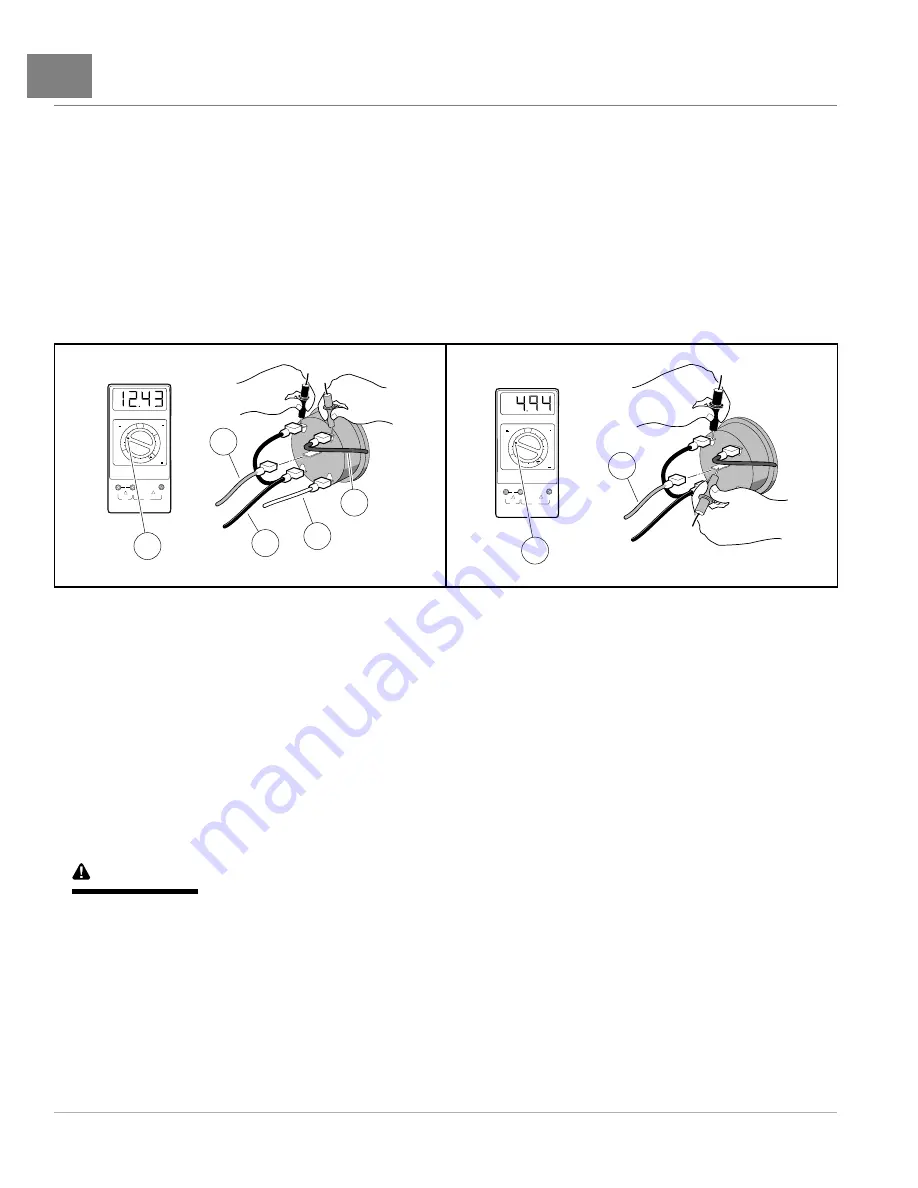
11
Test Procedures
TROUBLESHOOTING AND ELECTRICAL
SYSTEM: GASOLINE VEHICLES
4.
Set a multimeter to 20 volts DC and place the red (+) probe on the positive (+) post of the battery. Place the black
(–) probe on the negative (–) post of the battery. Record the voltage reading.
5.
Set a multimeter to 20 volts DC and place the red (+) probe on the (2) terminal of the fuel gauge/hour meter
where the blue wire (w25) is connected. Place the black (–) probe on the (1) terminal of the fuel gauge/hour meter
with the black wire (w22)
6.
Turn the key switch ON. The voltage reading should be the same as the battery voltage reading recorded earlier.
If not, check the continuity of the blue and black wires
7.
The orange wire should remain disconnected for this step. Place the black probe of the multimeter on the (1)
terminal of the fuel gauge/hour meter and place the red (+) probe on the (4) terminal of the fuel gauge/hour
meter
. The voltage reading should be approximately 4.94 volts. If the reading is
incorrect, replace the fuel gauge/hour meter.
2m
20
m
200
m
2k
200
200
200
200
20
2
200
m
500
20k
200k
2000
k
1000
OFF
WAVETEK
5XL
V
V
V
A
!
!
COM
200nA
MAX
1000 ---
750V
FUSED
1
4
2
6
7
1
4
5
3
2
1. 20 VDC Setting 2. Orange 3. Black 4. White 5. Blue
2m
20
m
200
m
2k
200
200
200
200
20
2
200
m
500
20k
200k
2000
k
1000
OFF
WAVETEK
5XL
V
V
V
A
!
!
COM
200nA
MAX
1000 ---
750V
FUSED
1
4
2
6
7
1
2
1. 20 VDC Setting 2. Orange
481
Figure 11-29
Fuel Gauge Voltage Test - Terminal 2
482
Figure 11-30
Fuel Gauge Voltage Test - Terminal 4
TEST PROCEDURE 32 – Hour Meter
See General Warnings, Section 1, Page 1-2.
NOTE:
Keep the battery connected during this test procedure.
1.
Place the Forward/Reverse handle in NEUTRAL. Chock the wheels.
2.
With the key switch OFF, check the hour meter display. It is powered by an internal battery and should always be
on, even with the engine off and the key removed.
3.
Start the engine and let it idle.
See following DANGER.
DANGER
• Do not operate vehicle in an enclosed area without proper ventilation. The engine produces carbon
monoxide, which is an odorless, deadly poison.
4.
With engine idling, the "hour glass" icon should flash. If not, check the low oil warning light and the oil pressure
switch.
See following NOTE. See alsoTest Procedure 28 – Low Oil Warning Light Circuit on page 11-33.
NOTE:
The hour meter is designed to record actual engine running time and will not start adding increments until the
engine is running and the oil pressure switch has opened.
5.
If the hour meter still does not function after the low oil warning light, oil pressure switch, and all of the appropriate
wires have been checked for continuity, replace the fuel gauge/hour meter.
Page 11-36
2016 Carryall 1500/1700 and XRT 1550 Maintenance and Service Manual
Summary of Contents for Carryall 1500 2016
Page 2: ......
Page 432: ...NOTES...
Page 433: ...NOTES...
Page 434: ...NOTES...
Page 435: ......
Page 436: ......































